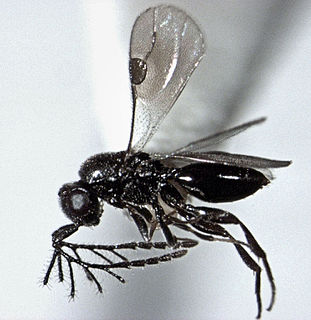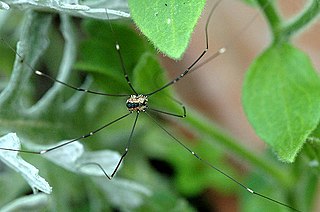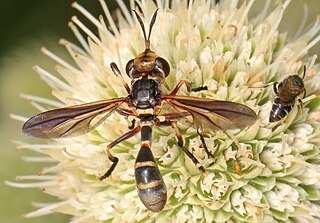
The Megaspilidae are a small hymenopteran family with 13 genera in two subfamilies, and some 450 known species, with a great many species still undescribed. It is a poorly known group as a whole, though most are believed to be parasitoids, and a few hyperparasitoids. Many are found in the soil, and of these, a number are wingless.
Aglaothorax is a genus of ovate shieldbacks in the family Tettigoniidae. There are about six described species in Aglaothorax.

Leiobunum is a genus of the harvestman family Sclerosomatidae with more than a hundred described species. Contrary to popular belief, they are not spiders, although they share a resemblance. They are arachnids, in the order Opiliones, harvestmen. Species in Leiobunum tend to have relatively long legs compared with other harvestmen, and some species are gregarious.

Leiobunum rotundum is a species of harvestman. It is found in the western Old World.
Andinomyia is a genus of bristle flies in the family Tachinidae. There are about five described species in Andinomyia.
Chrysotachina is a genus of bristle flies in the family Tachinidae. There are at least 25 described species in Chrysotachina.
Clausicella is a genus of bristle flies in the family Tachinidae.
Paradidyma is a genus of flies in the family Tachinidae.

Laphria is a genus described by Johann Wilhelm Meigen in 1803, belonging to the family Asilidae, subfamily Laphriinae. Members of this genus are known as bee-like robber flies. This genus has a Holarctic distribution, occurring in Europe, Asia, and North America. They prey on a variety of insects, including other robber flies, bees, wasps and beetles. Like other asilids, they use their proboscis to penetrate the body of their prey and inject enzymes which dissolve the tissues.

Chrysobothris is a genus of metallic wood-boring beetles in the family Buprestidae. There are at least 690 described species in Chrysobothris.

Physoconops is a genus of thick-headed flies in the family Conopidae. There are about 13 described species in Physoconops.
Opomydas townsendi is a species of mydas flies.
Opomydas is a genus of mydas flies. There are at least 3 described species in Opomydas.
Cesonia rothi is a species of ground spider in the family Gnaphosidae. It is found in the United States.

Ophiogomphus aspersus, the brook snaketail, is a species of clubtail in the family of dragonflies known as Gomphidae. It is found in North America.
Laphria gilva is a species of robber flies in the family Asilidae.
Belvosia townsendi is a species of bristle fly in the family Tachinidae. It is found in North America.

Leiobunum calcar is a species of harvestman in the family Sclerosomatidae. It is found in North America.

Leiobunum verrucosum is a species of harvestman in the family Sclerosomatidae. It is found in North America.

Neocurtilla is a genus of northern mole crickets in the family Gryllotalpidae. There are about seven described species in Neocurtilla, found parimarily in North, Central, and South America.









